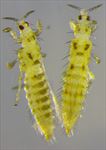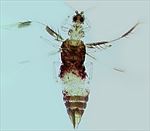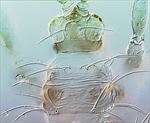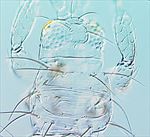
Scolothrips rhagebianus

Scolothrips asura female

Scolothrips latipennis head & pronotum

Scolothrips rhagebianus head & pronotum

Scolothrips rhagebianus fore wing
Generic diagnosis
Female macropterous. Head wider than long, maxillary palps 3-segmented; eyes large, with four pigmented facets; ocellar setae I present; setae I and II elongate nearly half as long as elongate setae III; four pairs of postocular setae. Antennae 8-segmented, segment I without paired dorso-apical setae, II with dorsal inner seta much longer than outer seta, III and IV with sense-cones forked, III with ventral microtrichial row, IV–VI with some microtrichia on both surfaces. Pronotum wider than long; six pairs of greatly elongate setae. Mesonotum with median pair of setae situated far from posterior margin; campaniform sensilla absent. Metanotum with median pair of setae situated at or near anterior margin; campaniform sensilla absent. Fore wings with veinal setae elongate, not closely placed, costal setae longer than anteromarginal cilia; clavus usually with three veinal and one discal setae; posteromarginal fringe cilia wavy. Prosternal ferna divided; basantra membranous, often with setae; prospinasternum usually narrow, curved posteriorly medially. Mesosternum with indistinct sternopleural sutures; endofurca with spinula. Metasternal endofurca with spinula. Tarsi 2-segmented. Tergites without ctenidia or craspeda, indistinctly divided from laterotergites; tergal discal setae small; VIII without comb; IX without anterior campaniform sensilla; X without longitudinal split. Sternites without craspeda or discal setae; sternites III–VII with three pairs of posteromarginal setae, II with two pairs; VII with S1 setae in front of margin.
Male similar to female; sternites III–VIII each with large transverse pore plate with median constriction.
Biological data
Living on many different plant species, the adults and larvae of members of this genus are predatory on leaf-feeding mites.
Distribution data
Members of this genus are widespread in the warmer parts of the world, but species in the Americas are now considered distinct from species in the Old World (Mound, 2011).
Nomenclatural data
Scolothrips Hinds, 1902: 157. Type species Thrips sexmaculata Pergande 1894, by monotypy.
There are 16 species listed in this genus (ThripsWiki, 2020), and an identification key to 14 of these was provided by Mound (2011). Although the following five species are recorded from China, only asura and rhagebianus are well characteriised; further evidence is needed to determine if the remaining three are distinct from each other or represent variants of a single species.
asura Ramakrishna & Margabandhu, 1931: 1035.
dilongicornis Han & Zhang, 1982: 53.
longicornis Priesner, 1926: 239.
rhagebianus Priesner, 1950: 46.
takahashii Priesner, 1950: 52.
Relationship data
Thripidae sub-family Thripinae: this is a diverse group involving more than 230 genera. The species of Scolothrips are unique in the chaetotaxy of the pronotum and fore wings, and as a result it is difficult to suggest any generic relationships.
References
Mound LA (2011) Species recognition in the genus Scolothrips (Thysanoptera, Thripidae), predators of leaf-feeding mites. Zootaxa 2797: 45–53.
ThripsWiki (2020). ThripsWiki - providing information on the World's thrips. <http://thrips.info/wiki/Main_Page>